The Big Picture
By Roberta Fujimoto Chu, President of the Board of Directors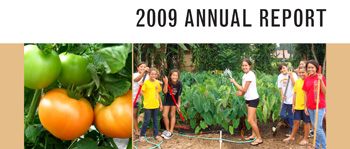
Eight years ago, The Kohala Center was founded with a mandate to create greater employment and educational opportunities by caring for and celebrating Hawai‘i Island’s spectacular natural and cultural landscape. Our staff has had the courage and the wisdom to listen to island residents and to truly address their needs with creative solutions.
Members of the board and I, as well as members of the staff, continue to be astonished and impressed by the inventiveness and pragmatism of island communities. When our board approved the establishment of the Hawai‘i Island School Garden Network (HISGN), ably organized by staff member Nancy Redfeather, we had no idea how meeting what seemed like a simple request would lead to such enormous possibilities for bolstering K-12 education, for enhancing the health of island residents, and for creating a more sustainable future for our society and economy. The momentum and immense transformative potential of the school garden movement reminds me that we have an unusual staff. (Please see the staff profiles beginning on p. 43 of the 2009 Annual Report.) While they have long professional histories and strong professional ties upon which to draw,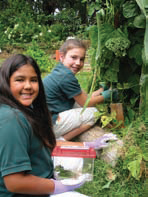 they are not so disciplined by their disciplines that they are unable to recognize novel solutions to challenges. These solutions usually arise from conversations with community partners who say, “Well, let’s just start small and begin with what we have at hand.” The school garden movement draws on the strength of our communities and on the creativity of island people—people who are driven by a sense of optimism.
they are not so disciplined by their disciplines that they are unable to recognize novel solutions to challenges. These solutions usually arise from conversations with community partners who say, “Well, let’s just start small and begin with what we have at hand.” The school garden movement draws on the strength of our communities and on the creativity of island people—people who are driven by a sense of optimism.
Consider this:
In 2009, HISGN expanded to serve 49 schools on the island. In partnership with the Ulupono Initiative, The Kohala Center provided direct financial support to 14 school gardens in the Network. These 14 gardens alone served 1,591 students who are cultivating 180,000 square feet of land to produce over 14,000 pounds of food. In the district of North Kohala, more vegetables are produced by the Kohala Youth Agriculture Project, a member of HISGN, than by any other farm in that community.
Learn more about our work, our partners, our staff, and our vision for the future. Read the 2009 Annual Report.

Meaningful Outdoor Experience
A cohort of 14 West Hawai‘i teachers and roughly 500 of their students are currently participating in The Kohala Center’s HI-MOES (Hawai‘i Island Meaningful Outdoor Experience for Students) Program. 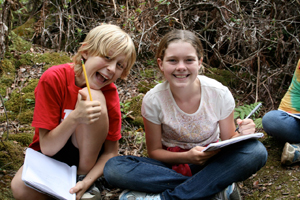 HI-MOES focuses on two ahupua‘a (watershed) complexes on Hawai‘i Island as centers for outdoor learning: Kahalu‘u in Kona and Kohala Mountain in Kohala. The aim of HI-MOES is to support a network of environmental educators in the public, charter, and private school system to provide meaningful outdoor place-based and science-based learning opportunities which promote environmental stewardship and which meet Hawai‘i Content and Performance Standards.
HI-MOES focuses on two ahupua‘a (watershed) complexes on Hawai‘i Island as centers for outdoor learning: Kahalu‘u in Kona and Kohala Mountain in Kohala. The aim of HI-MOES is to support a network of environmental educators in the public, charter, and private school system to provide meaningful outdoor place-based and science-based learning opportunities which promote environmental stewardship and which meet Hawai‘i Content and Performance Standards.
Teachers and their students are taking field trips to these two very different areas of the island to learn about watershed and bay ecosystems. Each school is undertaking a variety of scientific research projects, designing experimental protocols, and collecting data in the field.
Photo: HPA 7th grade students Alex Cavaliere and Kaipolani Hubbard record their observations made during an introductory activity at Pu‘u o Umi Natural Area Reserve on Kohala Mountain.
Here is 7th grader Kaipolani Hubbard’s poem about her first day in the forest with the HI-MOES Program:
Infinite children crowd into the van.
Not my favorite road to travel on.
Scenery takes me hostage.
Heard so many beautiful noises.
Oh so many sights to see.
Red and yellow birds in every tree.
Tasting roots and ferns was so cool!
I’m in total awe!
Listening to the wind, waterfall, and nature.
Oh my, never so relaxed.
Very interesting smelling mango leaves.
Every sound was music to my ears.
Definitely worth the bumpy ride.
In total shock of nature’s capabilities.
The best field trip ever!
Some of the students participating in HI-MOES have never been on a school field trip. Often there are challenges to outdoor-based education, such as lack of funding, difficulties scheduling activities outside of school due to logistics and transportation, and lack of appropriate field-based or data collection equipment. HI-MOES aims to alleviate some of these challenges so that teachers and their students can spend time outdoors, learning hands-on about different ecosystems. We hope to be able to assist teachers to incorporate field research into their classes and start long-lasting research projects that can continue year after year. In addition, exposing students to professional scientists in the field is inspiring and can open their eyes and understanding to a whole new world of science. —Samantha Birch, Kohala Center Field Educator
Learn more about the field projects now underway in "There’s Life in These Streams!" on the Back Page.

Like Nowhere Else on Earth
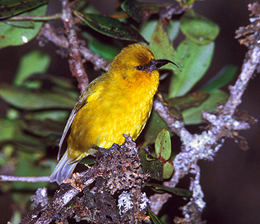
Photo: The rare and endangered ‘akiapōlā‘au occurs in only a few areas of upper elevation koa/‘ōhi‘a forest on Hawai‘i Island. Photo credit © Jack Jeffrey.
Hakalau Forest National Wildlife Refuge (NWR) is a very special rain forest, as it has one of the oldest broad leaf tree forests in the northern hemisphere. It also contains some of the rarest plants and birds in the world. You’ll have the opportunity to see, smell, feel, and hear a Hawaiian rainforest, found nowhere else on Earth. —Jack Jeffrey
The public is invited to join The Kohala Center (TKC) for our first Circle of Friend’s event of 2010, a two-mile hike through native montane rainforest which is home to 12 species of native birds, 5 of which are endangered. Join award-winning photographer, birder, and wildlife biologist Jack Jeffrey on Saturday, January 23, from 7:00 a.m. to 3:30 p.m., for a special journey into the Hakalau Forest NWR in search of rare and endangered birds. Jeffrey will explain how reforestation efforts at the NWR are restoring a healthy native ecosystem and leading to recovery of native bird and plant populations. Jeffrey is an entertaining storyteller and participants will learn more about the history of the refuge, as well as tour a 100-year-old koa cabin on the site.
Current Friends of TKC’s Circle of Friends pay just $25 for this excursion, which includes lunch. Cost is $75 for new Friends, which includes the event; subsequent excursions are just $25. For details about upcoming learning events and to download registration forms, visit the Birds, Bees & a Little Bit of Chocolate pages on our Web site. Other trips planned this year are Chocolate Growing and Production on Kuaiwi Farm in Kealakekua on February 13, Beekeeping and Volcano Island Honey with Richard Spiegel on March 20, and the Keauhou Bird Conservation Center and Kipuka Puaulu with Jack Jeffrey on May 15.

Healthy Soil for Healthy Bodies
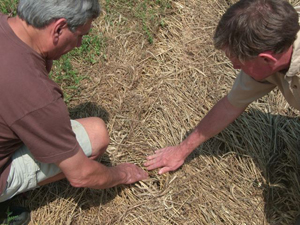
Photo: Jerry Brunetti and Dr. Paul Hepperly, experts on sustainable agriculture and conference presenters, check out the mulch layer from the rolling down and crimping of the cover crop.
We believe a sustainable society must be built on a sustainable agricultural foundation—which means building and growing healthy soils. The basis of any healthy natural system is the balance of beneficial microbes. If we grow nutrient rich foods, they will contain all the beneficial flora we need. The agricultural practices that enable farmers to grow nutrient rich foods enhance the soil by promoting conditions for the growth of beneficial micro-flora. From this foundation comes health and wellness for the entire community.
—Steve Sakala, Wai‘aha Farm Manager
Healthy soil, nutrient-rich foods, and a healthy body! Explore the relationship between physical health and soil health at Hawaiʻi Island’s first Body and Soil Farm Health Conference on January 23 and 24 at Wai‘aha Whole Systems Farm in Hōlualoa, Kona. The conference, “Culturing the Micro-Flora of the Body & Soil,” focuses on agricultural practices to grow nutrient-rich food. Conference attendees will learn sustainable agricultural practices that they can directly apply to their farms and gardens in order to grow nutrient-rich foods. “Attendees will learn how to foster biological diversity and sustainability in their gardens and farms and to grow foods that have direct and indirect health benefits,” explains Sakala, conference organizer and Wai‘aha Farm manager.
The conference features nationally recognized experts on sustainable agriculture and global health, who will discuss topics ranging from cover crops, to soil science, to heavy metals and how they affect nutrient uptake in the body.
Learn more about the Body and Soil Farm Health Conference on the Back Page.

The Hawaiian Language Shall Live
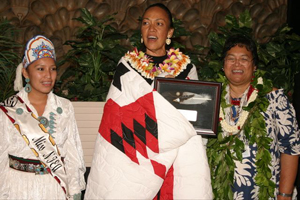
Photo: Kauanoe Kamanā (center) accepts the 2007 Cultural Freedom Award on behalf of the ‘Aha Pūnana Leo, Inc., at the National Indian Education Association’s national conference at the Hawai‘i Convention Center in Honolulu. She is pictured singing “Hele au i ka Pūnana Leo” with NIEA president Verlie Ann Malina Wright (right) and off-camera staff and families at this gala event.
In this issue we are pleased to feature the work of Mellon-Hawai‘i Doctoral Fellow Kauanoe Kamanā, who is earning a Ph.D. in Hawaiian Language and Indigenous Language and Culture Revitalization at the College of Hawaiian Language at the University of Hawai‘i (UH) at Hilo. Kauanoe’s dissertation title is “Ke Ō O Ka ʻIke Kuʻuna Ma O Ka Moʻokiʻina Hoʻoponopono Ma Ke Kula ʻO Nāwahīokalaniʻōpuʻu: Living Traditional Culture through the Contemporary Application of the Conflict Resolution System, Moʻokiʻina Hoʻoponopono, at Ke Kula ʻO Nāwahīokalaniʻōpuʻu School.”
I became involved in establishing the ‘Aha Pūnana Leo as a parent and as a teacher of Hawaiian language. As teachers, we were concerned about the fate of the Hawaiian language and about the death of our culture in Hawai‘i. The last native speaking kūpuna (elders) were alive and working with us at the time. We all knew that their days were numbered. The mission of the ‘Aha Pūnana Leo, E Ola Ka ‘Ōlelo Hawai‘i, “The Hawaiian Language Shall Live,” means that the culture will thrive as a result of perpetuating the language.
The majority of Pūnana Leo school children are still learning English or Hawai‘i Creole English as the language of the family. Unfortunately, only 2% of all Hawaiian children in the public schools attend Hawaiian medium schools. The ‘Aha Pūnana Leo is the leading entity in Hawai‘i and in the United States that is committed to the revitalization of Hawaiian language. As a result, Pūnana Leo’s efforts are positively impacting the health and vitality of the Hawaiian culture and the Hawaiian worldview among all of Hawai‘i’s people. —Kauanoe Kamanā, 2009 Mellon-Hawai‘i Doctoral Fellow
Read Kauanoe’s story "Living Traditional Culture” on the Back Page.
The Mellon-Hawai‘i Fellowship recognizes Hawai‘i’s leading thinkers and writers. Through the Fellowship Program, doctoral fellows are given the opportunity to complete their dissertations before accepting their first academic posts. Postdoctoral fellows are given the opportunity to publish original research early in their academic careers. Doctoral fellows are awarded $40,000 for the academic year, and postdoctoral fellows are awarded $50,000. Application materials for the academic year 2010–2011 are now available on our Web site at http://kohalacenter.org/mellon/app.html. Completed applications must be received by 5:00 p.m. on Monday, February 15, 2010.

Spotlight on School Gardens:
Honoka‘a High School Agriculture Program
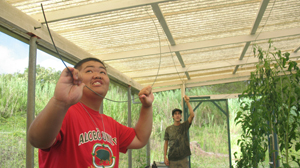
Photo: Students installing an irrigation system to hold "upside down gardens."
The fact that there is an agriculture program at our school is awesome. I value many things about the Honoka‘a ag program, but especially the hands-on experience it provides compared to other classes. The agriculture program is helping me with my future, preparing me to become a construction worker. I learn the basics of measuring, constructing different structures, and working with other students. —Kaimana Lutey, senior at Honoka‘a High School in his third year in the Agriculture Program
Students at Honoka‘a High School have a broad spectrum of agriculture-related courses to choose from during their high school careers, including Natural Resources, Agricultural Technology, Horticulture, Agricultural Science, Aquaculture, and Plants and Animals of Hawai‘i. Manuel Jadulang teaches all of these classes, and he believes the program offers something for every interest. “My agriculture classes encompass everything from animals (i.e., feeding and handling them); caring for the ‘āina (land); growing vegetable crops in fields, greenhouses, hydroponically, and aquaponically; construction skills (use of different carpentry tools and equipment); forestry; aquaculture; irrigation; and other topics. I believe this kind of knowledge and experience is something students will remember and use some time later in their lives,” says Jadulang.
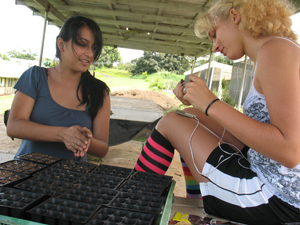
Photo: Students seeding trays for future plantings.
Honoka‘a’s Agriculture Program facilities include six greenhouses (circulating and non-circulating hydroponics, tropical flowers, vegetables, and native plants), an agriculture shop, a plant tissue culture lab, a golf course, and an aquaculture area for freshwater ornamental fish and aquaponics. Students in the program work on projects ranging from maintaining the program’s golf course and grounds using lawn equipment to planting an herb garden. Agriculture projects involve students in growing vegetable field crops and cultivating native plants, working in the shop to maintain farm equipment and learn welding and small farm woodworking, setting up and managing a fresh water ornamental aquarium, working in the plant tissue lab doing micro-propagation, and tilapia aquaculture and aquaponics. This year the students have fenced off an area for a sustainable garden plot, using ducks and chickens to fertilize this paddock. Students just completed a chicken tractor to be used in this system.
In 2008–2009, The Kohala Center provided funding and support to the Honoka‘a Agriculture Program through the Hawai‘i Island School Garden Network (HISGN). “The Kohala Center has been a tremendous asset to our program,” explains Jadulang, “by facilitating networking opportunities that can help us to transition from chemical to organic agriculture and develop a composting and nutrient recycling area.”
Read "Knowledge They Can Use" on the Back Page to learn more.

The Art and Science of Map-Making
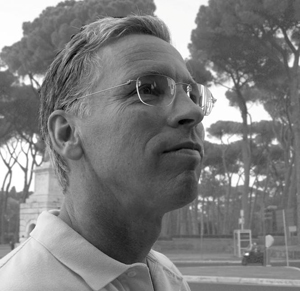
Photo: Thomas Dye.
Whether maps are drawn with pencil and paper, aided only by a measuring tape and compass, or designed on a high-speed computer using the latest laser scanning technology, the result gains meaning only through interpretation. —Thomas Dye, archaeologist
The first Puana Ka ‘Ike (Imparting knowledge) and Eia Hawai‘i (Here is Hawai‘i) lectures of 2010 will feature a brief history of archaeological map-making in Hawai‘i. Archaeologist Thomas Dye will speak on the art and science of archaeological map-making in Kona from 5:30 to 7 p.m. on Friday, January 22, at the Keauhou Beach Resort Ballroom, and in Hilo from noon to 1:30 p.m. on Monday, January 25, at the University of Hawai‘i at Hilo in University Classroom Building 127. Dye will discuss the role of interpretation in archaeological map-making in Hawai‘i, with special reference to maps of heiau (temple) foundations, including those in Kahalu‘u.
Dye graduated from Kailua High School and UH Mānoa before earning a Ph.D. at Yale University. During his 41 years practicing archaeology, he has taught at Hawai‘i Pacific University and at UH Mānoa, served as O‘ahu Island Archaeologist for the State Historic Preservation Division, and worked for various archaeological consulting firms, including the Bishop Museum. He is currently president of T. S. Dye & Colleagues, Archaeologists, Inc., an archaeological consulting firm in Honolulu.
The Puana Ka ‘Ike and Eia Hawai‘i lecture series are presented in partnership with Kamehameha Investment Corporation/Kamehameha Schools, The Kohala Center, the Kīpuka Native Hawaiian Student Center at UH Hilo, and Keauhou Beach Resort. For more information, a schedule of upcoming lectures, and videos of previous lectures, visit http://kohalacenter.org/puanakaike/about.html.

Good Times on Kohala Mountain
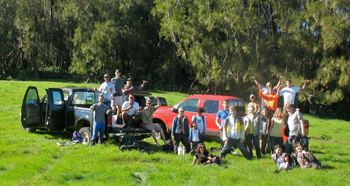 Photo: KWP volunteers celebrate the end of another successful work day on Kohala Mountain. Photo by Melora Purell.
Photo: KWP volunteers celebrate the end of another successful work day on Kohala Mountain. Photo by Melora Purell.
MAHALO to all of you, our wonderful volunteers, for your work to protect and restore the watersheds of Kohala Mountain in 2009! In the last two years, our volunteers have planted over 5,000 trees. Our volunteers work hard, make new friends, explore areas that other island residents rarely have access to, experience breathtaking views, and learn about our native plants. We hope you can join us for many more good times in 2010. —Melora Purell, Coordinator of Kohala Watershed Partnership (KWP)
KWP will host two volunteer work dates per month starting in January 2010. Work sites will alternate between the dry and wet sides of Kohala Mountain, so that volunteers can experience both environments during the course of each month. All work days will involve weed removal, outplanting, or trail work. Work days are scheduled for the following Saturdays: January 16, January 23, February 13, February 20, March 13, March 20, April 10, April 17, May 15, and May 22. Learn more about volunteering with KWP at http://www.kohalacenter.org/kwppelekane/volunteer.html.


Subscribe to Kalei Nu‘uhiwa's Hawaiian Moon Newsletter.
Please click here and then send from your e-mail. Mahalo!

